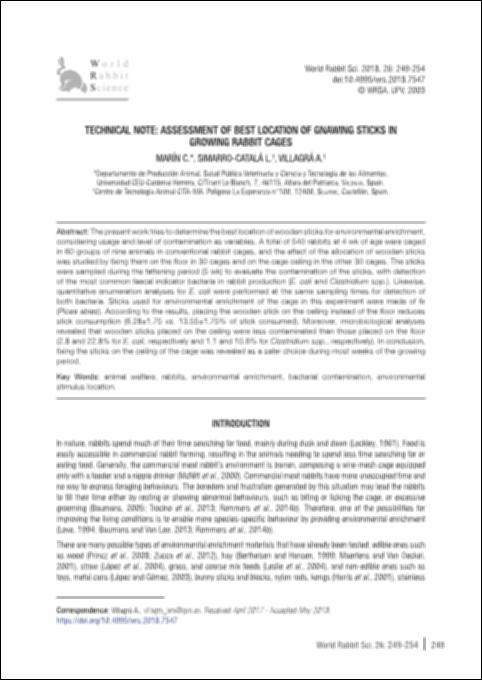Please use this identifier to cite or link to this item:
http://hdl.handle.net/10637/10003Technical note : assessment of best location of gnawing sticks in growing rabbit cages
| Title: | Technical note : assessment of best location of gnawing sticks in growing rabbit cages |
| Other Titles: | Assessment of best location of gnawing sticks in growing rabbit cages |
| Authors : | Marín Orenga, Clara Simarro Catalá, Laura Villagrá García, Aránzazu |
| Keywords: | Conejos - Alimentación.; Bienestar animal.; Animal welfare.; Rabbits - Feeding and feeds.; Rabbits - Environmental aspects.; Rabbits - Breeding.; Cunicultura.; Conejos - Aspectos ambientales. |
| Publisher: | Universitat Politècnica de València,Instituto de Ciencia y Tecnología Animal World Rabbit Science Associated. |
| Citation: | Marín, C., Simarro-Catalá, L. & Villagrá, A. (2018). Technical note : assessment of best location of gnawing sticks in growing rabbit cages. World Rabbit Science, vol. 26 (july-september 2018), n. 3, pp. 249-254. DOI: https://doi.org/10.4995/wrs.2018.7547 |
| Abstract: | The present work tries to determine the best location of wooden sticks for environmental enrichment, considering usage and level of contamination as variables. A total of 540 rabbits at 4 wk of age were caged in 60 groups of nine animals in conventional rabbit cages, and the effect of the allocation of wooden sticks was studied by fixing them on the floor in 30 cages and on the cage ceiling in the other 30 cages. The sticks were sampled during the fattening period (5 wk) to evaluate the contamination of the sticks, with detection of the most common faecal indicator bacteria in rabbit production (E. coli and Clostridium spp.). Likewise, quantitative enumeration analyses for E. coli were performed at the same sampling times for detection of both bacteria. Sticks used for environmental enrichment of the cage in this experiment were made of fir (Picea abies). According to the results, placing the wooden stick on the ceiling instead of the floor reduces stick consumption (6.28±1.75 vs. 13.55±1.75% of stick consumed). Moreover, microbiological analyses revealed that wooden sticks placed on the ceiling were less contaminated than those placed on the floor (2.8 and 22.8% for E. coli, respectively and 1.1 and 10.6% for Clostridium spp., respectively). In conclusion, fixing the sticks on the ceiling of the cage was revealed as a safer choice during most weeks of the growing period. |
| Description: | Este artículo se encuentra disponible en la página web de la revista en la siguiente URL: https://polipapers.upv.es/index.php/wrs/article/view/7547/10561 |
| URI: | http://hdl.handle.net/10637/10003 |
| Rights : | http://creativecommons.org/licenses/by-nc-nd/4.0/deed.es |
| ISSN: | 1257-5011. 1989-8886 (Electrónico). |
| Issue Date: | 1-Jul-2018 |
| Center : | Universidad Cardenal Herrera-CEU |
| Appears in Collections: | Dpto. Producción y Sanidad Animal, Salud Pública Veterinaria y Ciencia y Tecnología de los Alimentos |
Items in DSpace are protected by copyright, with all rights reserved, unless otherwise indicated.


